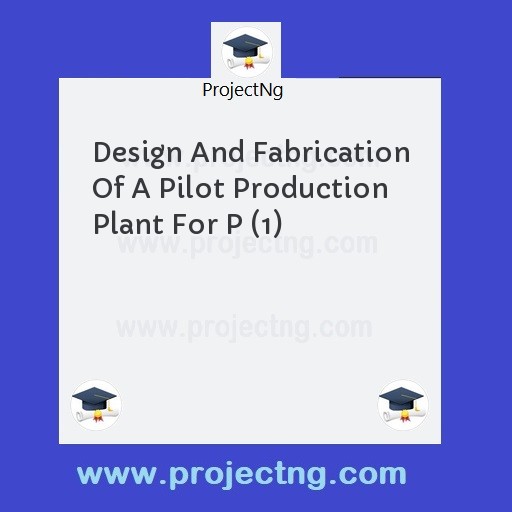Design And Fabrication Of A Pilot Production Plant For P (1)
Mechanical Engineering Project Topics
Get the Complete Project Materials Now! »
DESIGN AND FABRICATION OF A PILOT PRODUCTION PLANT FOR P (1)
ABSTRACT
The concept of this project is to actualize a practical way of paint production using a locally design mixing machine which is design to meet a low cost and high standard paint.
The project cut across all forms of engineering, such as mechanical machine design of a simple industrial mixer, which is driven by an electrically made device, a 3 HP electric motor, chemically reacting reagents such as water, calcium carbonate, etc to produce the desired product which is aim to be used as coat for Mechanical Agricultural and Civil structures.
The project research exposes to students and entrepreneur to total knowledge necessary for the production of emulsion and texcoat using a single mixer irrespective of the volume of production. Self help project is the only sustainable solution to the problem of unemployment. Many unemployed youth can lay their hiring. The project research is a modest presentation of simplified facts on the for entrepreneur success at a low coat.
TABLE OF CONTENTS
Title page
Letter of transmittal
Authority page
Certification
Dedication
Acknowledgement
Abstract
Table of contents
CHAPTER ONE
Introduction
Objectives of the research work
Uses and economics
Importance of study
Benefits of the project
CHAPTER TWO
Literature review
Historical
Design of mixing machine
Recognition of need
Definition of problem
Planning for production
Planning for use
Process of design
Factors that determine choice of material
Packaging of product (ames paint)
CHAPTER THREE
Design of machine/sequence of operation
Design and construction details
Design factors/construction of the principles
Construction procedures
CHAPTER FOUR
Paint production
Latex paint
White wash
Paint composition
Paint constituents for emulsion
Quality control
Chalking, abrasion, hardness & adherence
Formation of emulsion paint 20 litres
Formation of texcoat (20 litres)
CHAPTER FIVE
Characteristics of the project
Performance of the project
Conclusion
Recommendation
References
CHAPTER ONE
INTRODUCTION
A pilot production plant for paint is a chain une of pant production, from the design of the machine, the mixing of the chemical to the packaging. All is aim at production of both (texcoat) and emulsion (water based paints) which are basically classified as one of the two classes of paint.
PAINT CAN BE CLASSIFIED INTO
- GLOSS PAINTS (OIL BASED PAINTS)
These are paints that may be classified according to whether the drying mechanisms is predominantly solvent evaporation, oxidation or some chemical reaction. Gloss paints which dry essentially by solvent evaporation, rely on a fairly hard resin as the vehicle. Paints which dry by oxidation, the vehicle is usually an oil or an oil – based varnish, these usually contain driers to accelerate the drying of the oil. Paint based essentially on oil with suitable pigment such as Titanium dioxide, extenders, and usually zinc – oxide and white lead are conventional outside house paints because these materials give the combination of the properties which meet this requirement.
- EMULSION/TEXCOAT PAINTS (WATER – BASED PAINTS)
These are paints with water soluble vehicle and they includes calcimines, in which the vehicle is glue an case in paints, in which the vehicle is casein or soybean protein.
OBJECTIVES OF THE RESEARCH WORK
The objectives of the research project work is to study the formulation, production of a low cost simple mixing machine and the production of paints, both glass and emulsion in with the use of local pigment and extenders as raw materials. This is highly beneficial for small scale for hence the cost of production is far reduced compared to paint produce by industries using imported machines and materials.
USES AND ECONOMICS
Paints preserve architectural structure from weather attacks. Uncoated wood and metal deteriorate, especially in present of soot, C. and sulphur dioxide, S02. Thus, S02 in the atmosphere reacts with water vapour, both gases (g), to form aqueous 9aq) S02 which reacts further with water to form sulphuorus acid, H2 S04, from which S032 reacts with metals, eg copper CU2+ as follows
![]() (S02) (g) + H20 (S02) (aq)
(S02) (g) + H20 (S02) (aq)
![]() (S02) (aq) + H20 H2 S03
(S02) (aq) + H20 H2 S03
![]() S032- + CU2+ S03- + CU+
S032- + CU2+ S03- + CU+
IMPORTANCE OF STUDY
Paints also increase the attractiveness of manufactured products, as well as the aesthetic appeal of dwelling. Thus, paints serve utility and art purpose. In the United State of America, paints annual sales clocked N4 billion (100 billion) in 1971, industrial paints for the first time sold more than architectural paints, indicating a shift in trend. This highlights the importance of paint ventures in a developing economy, such as Nigeria’s.
BENEFITS OF THE PROJECT
Students and industrialists alike in developing countries lack the basic and simplified techniques on pants making; yet paints are a class of products that serves important aesthetic, protection and functional values. The few available paints makers are so specialized or professional in presentation that the seem scaring to interested students and industrialist. The objective of the project pilot production plant for pant simplified paint making; thereby motivating entrepreneur aspiring in pant making given them adequate viable market as a result of low cost of production.
Be the First to Share On Social

Enjoying our content?
Don't miss out on new videos! Subscribe to our YouTube channel for more awesome content.
Subscribe Now!













